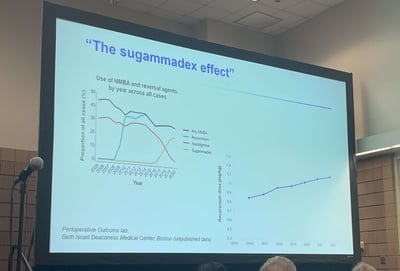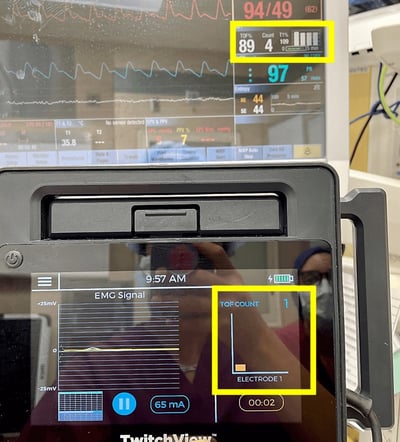Why Do the ASA Guidelines Recommend the Adductor Pollicis?

The Adductor Pollicis vs. The Eye Muscles
To assess the patient's level of block, it is common practice to apply a peripheral nerve stimulator to the patient's face and observe/assess the response of the eye muscles. The ESAIC and ASA guidelines recommend against assessments of the face and strongly encourage providers to use quantitative neuromuscular monitoring to objectively measure the adductor pollicis muscle in the hand [1]. What is the clinical significance of the change in practice?
In the following case study, a provider compared assessments of the face to measurements taken at the patient’s hand using TwitchView, an electromyographic quantitative monitor. The case was a routine hardware removal expected to last 2 hours. Forty-five minutes after induction, the surgeon began closing. A 0.6mg/kg intubating dose of rocuronium had been administered with no additional maintenance doses. At the time, TwitchView measured a post-tetanic count (PTC) of 8, which the ASA guidelines define as deep block. When the provider applied a peripheral nerve stimulator to the patient's facial nerve, they observed a TOFC 4 with possible fade, which the ASA guidelines define as shallow block.
PTC 8 measured at the adductor pollicis vs. TOFC 4 observed on the face
The recommended reversal agent for both shallow and deep block is sugammadex, while neostigmine is indicated for minimal block [1]. In this case, the provider administered a 50mcg/kg dose of neostigmine.
The TOF Monitoring Site Impacts Clinical Decisions
After 25 minutes, the TwitchView measured a TOFC 3 while four strong twitches without fade were observed on the patient's face. The patient was breathing spontaneously and pulling good tidal volumes. To determine if additional recovery was possible, the provider administered a 2mg/kg dose of sugammadex. Within 5 minutes, a TOFR of 98% was measured by TwitchView.
Figure 1: Graphic recreation of the TwitchView monitor trend plot with callouts highlighting individual dosing events
Source: Author
When eye muscles are used to assess patient recovery, residual neuromuscular block is five times more likely to occur. Increased incidence is likely due to 1) the faster recovery rate of the commonly assessed eye muscles relative to the adductor pollicis and 2) direct muscle stimulation being mistaken for twitches [2].
Monitoring the Adductor Pollicis Improves Patient Safety
In this case study, facial assessments led the provider to select an inadequate reversal strategy, and the patient could have been extubated at a TOFC 3 as measured at the adductor pollicis. Even if the provider had selected sugammadex instead of neostigmine, the TOFC 4 at the eye would have indicated 2 mg/kg dosing—not the 4 mg/kg dosing recommended for a PTC 8 [3]. Multiple studies have demonstrated that insufficient sugammadex dosing can result in incomplete reversal and recurarization after a successful initial recovery [4].
On the other hand, Thilen et al. used TwitchView to eliminate the occurrence of residual paralysis, and 20% of all study patients spontaneously recovered requiring no reversal [5]. Although the hands are often tucked and/or inaccessible during surgery, EMG-based technologies, like TwitchView, do not require physical movement and can therefore provide accurate, quantitative measurements throughout any case. To minimize workflow disruption, providers can place the EMG electrode while placing the BP cuff, pulse-ox and EKG leads and realize the benefits of an additional continuous, quantitative measurement.
Learn more about TwitchView or contact your regional representative today!
- Stephan R. Thilen, Wade A. Weigel, Michael M. Todd, Richard P. Dutton, Cynthia A. Lien, Stuart A. Grant, Joseph W. Szokol, Lars I. Eriksson, Myron Yaster, Mark D. Grant, Madhulika Agarkar, Anne M. Marbella, Jaime F. Blanck, Karen B. Domino; 2023 American Society of Anesthesiologists Practice Guidelines for Monitoring and Antagonism of Neuromuscular Blockade: A Report by the American Society of Anesthesiologists Task Force on Neuromuscular Blockade. Anesthesiology2023; 138:13–41 doi: https://doi.org/10.1097/ALN.0000000000004379
- Thilen SR, Hansen BE, Ramaiah R, Kent CD, Treggiari MM, Bhananker SM. Intraoperative neuromuscular monitoring site and residual paralysis. Anesthesiology. 2012;117:964-972.
- Dosing for BRIDION® (sugammadex). https://www.merckconnect.com/bridion/dosing-administration/. 24 June 2024.
- Fuchs-Buder, Thomas. Less is not always more: sugammadex and the risk of under-dosing. European Journal of Anaesthesiology 27(10):p 849-850, October 2010. | DOI: 10.1097/EJA.0b013e32833dce3a
- Thilen, Stephan R. MD, MS*; Sherpa, James R. MD†; James, Adrienne M. BS*; Cain, Kevin C. PhD‡; Treggiari, Miriam M. MD, MPH, PhD§; Bhananker, Sanjay M. MBBS, MD, FRCA*. Management of Muscle Relaxation With Rocuronium and Reversal With Neostigmine or Sugammadex Guided by Quantitative Neuromuscular Monitoring. Anesthesia & Analgesia ():10.1213/ANE.0000000000006511, May 12, 2023. | DOI: 10.1213/ANE.0000000000006511




